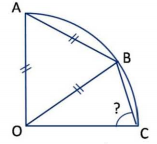 Multiple Choice Questions
Multiple Choice QuestionsA river is 4.1 km wide. A bridge built across it has 1/7 of its length on one bank and 1/8 of its length on the other bank. What is the total length of the bridge?
5.1 km
4.9 km
5.6 km
5.4 km
OA, OB, and OC are radii of the quarter circle shown in the figure. AB is also equal to the radius.

What is angle OCB?
60°
75°
55°
65°
Two iron spheres of radii 12 cm and 1 cm are melted and fused. Two new spheres are made without any loss of iron. Their possible radii could be
9 and 4 cm
9 and 10 cm
8 and 5 cm
2 and 11 cm
A man buys alcohol at Rs. 75/cL, adds water and sells it at Rs. 75/cL making a profit of 50%. What is the ratio of alcohol to water?
2:!
1:2
3:2
2:3
The sum of the digits of a two-digit number is 9. If the fraction formed by taking 9 less than the number as numerator and 9 more than the number as the denominator is 3/4, what is the number?
36
63
45
54
The distance between X and Y is 1000 km. A person flies from X at 8 AM local time and reaches Y at 10 AM local time. He flies back after a halt of 4 hours at Y and reaches X at 4 PM local time on the same day. What is his average speed for the duration he is in the air?
500 km/ hour
250 km/ hour
750 km/ hour
Cannot be calculated with the given information.
If a person travels x% faster than normal, he reaches y minutes earlier than normal. What is his normal time of travel?
A.
Normally considering, distance = speed ^ time
Modified case, (speed +
or, speed (1 +
Substituting for distance, speed
on cancelling speed on RHS and LHS,
1 + x/100 = time/ time - y
time = time - y + (time - y)/ 100
100 time = 100 time - 100 y + time - xy
x time = 100y + xy
time = (100/ x + 1) y minutes.
A and B walk up an escalator one step at a time, while the escalator itself moves up at a constant speed. A walks twice as fast as B. A reaches the top in 40 steps and B in 30 steps. How many steps of the escalator can be seen when it is not moving?
30
40
50
60
Which of the following mutagens is most likely to result in a single amino acid change in a gene product?
Acridine orange
X-rays
Ethylmethane sulphonate (EMS)
Ethidium bromide
Which one of the following analytical techniques does not involve an optical measurement?
ELISA
Microarray
Flow cytometry
Differential Scanning Calorimetry
